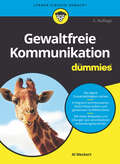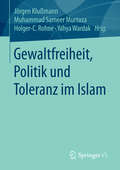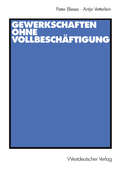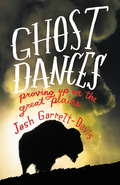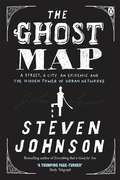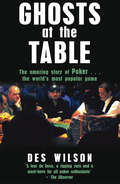- Table View
- List View
Gewaltfreie Kommunikation für Dummies (Für Dummies)
by Al WeckertMöchten auch Sie einfühlsamer kommunizieren? Al Weckert erläutert Ihnen die vier Schritte der Gewaltfreien Kommunikation nach Marshall B. Rosenberg: urteilsfreie Beobachtung, Gefühle, Bedürfnisse, Bitten, die eine wertschätzende Kommunikation mit dem Gegenüber ermöglichen. Sie erfahren anhand vieler Beispiele und Übungen, wie die Gewaltfreie Kommunikation im Beruf, in der Partnerschaft und der Erziehung Konflikte entschärft und hilft, Lösungen zu finden, in denen die Belange aller Beteiligten berücksichtigt werden. Außerdem gibt er denen, die Gewaltfreie Kommunikation weitergeben wollen, zahlreiche Hinweise zur Aus- und Weiterbildung.
Gewaltfreiheit, Politik und Toleranz im Islam
by Jörgen Klußmann Muhammad Sameer Murtaza Holger-C. Rohne Yahya WardakDer Islam gilt seit dem 11. September 2001 vielfach als eine gewalttätige Religion. Das fordert dazu heraus, sich mit dem kulturellen und religiösen Erbe des Islam gründlicher zu befassen. Die Autoren beschreiben eine im Westen weitgehend unbekannte Seite des Islam, die sich durch den Glauben, das Recht und den frühen Fortschrittsglauben der muslimischen Gelehrten entfalten konnte. Trotz des Niederganges der islamischen Rechtsprechung, der schari'a, und der Verhärtung des Glaubens hat sich die traditionelle Toleranz des Islam anderen Religionen gegenüber, erhalten. Moderne islamische Theologen treten für Gewaltlosigkeit ein.
Gewaltgedächtnisse: Analysen zur Präsenz vergangener Gewalt (Soziales Gedächtnis, Erinnern und Vergessen – Memory Studies)
by Nina Leonhard Oliver DimbathGewalt hat stets eine Geschichte. Diese bezieht sich sowohl auf das, was vor einem Gewaltereignis geschehen ist, als auch darauf, was nach diesem Ereignis eintritt. Gedächtnissoziologisch gefasst, wirft dies Fragen nach den Verkettungen und Bahnungen von Gewalt im Verlauf der Zeit auf. Von zentraler Bedeutung ist hier das Moment der Störung sozialer Ordnung, welches Gewalthandeln ebenso auslösen kann, wie es aus diesem in der Regel resultiert. In der Folge kommt es dann zur gewaltsamen oder gewaltlosen (Re-)Konsolidierung sozialer Ordnung. Die in diesem Band versammelten Beiträge analysieren sozialtheoretisch und anhand von Fallbeispielen, wie Gewalt fortgesetzt oder unterbrochen, verschwiegen oder thematisiert, legitimiert oder verurteilt wird. Auf diese Weise arbeiten sie Muster und Mechanismen von Sinn- beziehungsweise Strukturbildungsprozessen des gedächtnishaften und mitunter erinnernden Rückbezugs auf vergangene Gewaltereignisse heraus.
Gewaltpotentiale des Fernsehangebots: Programmangebot und zielgruppenspezifische Interpretation
by Werner ÜhDer Gewaltbegriff ist noch nicht hinreichend definiert. Außerdem wird bei Inhaltsanalysen des Fernsehprogramms unterstellt, dass das gemessene Gewaltpotential auch für das Publikum den relevanten Stimulus darstellt. Tatsächlich interpretiert das Publikum das Medienangebot aber auf seine je unterschiedliche Weise. Die evaluierten Wahrnehmungsparameter lassen sich in Zukunft für beliebig viele weitere Inhaltsanalysen verwenden, um das zielgruppenspezifische Gewaltpotenzial zu berechnen
Gewerkschaften im Umbau des Sozialstaats: Der Einfluss der Dachverbände im Welfare-to-Work-Reformprozess in Dänemark, Deutschland und den USA
by Michaela SchulzeDänemark, Deutschland und die USA repräsentieren drei verschiedene Typen von Wohlfahrtsstaatlichkeit. Sie unterscheiden sich sowohl im Hinblick auf ihre Entwicklungswege, ihre Institutionen und Systeme industrieller Beziehungen und Sozialleistungen als auch in der Entwicklung der Gewerkschaften und in den Politiken zum Umbau des Wohlfahrtsstaats. Michaela Schulze untersucht, inwieweit die Gewerkschaften, hier repräsentiert durch ihre jeweiligen Dachverbände, politischen Einfluss auf jene Reformprozesse haben ausüben können, die seit den 1980er Jahren unter dem Stichwort Welfare State Retrenchment zusammengefasst worden sind.
Gewerkschaften ohne Vollbeschäftigung
by Peter Bleses Antje VetterleinDie Bundesrepublik Deutschland war bis in die 70er Jahre hinein eine traditionelle Vollbeschäftigungsgesellschaft. Vor allem die Gewerkschaften verknüpften ihre politischen Strategien eng mit diesem Vollbeschäftigungsmodell. Sie sind daher stark von den Auflösungstendenzen der traditionellen Vollbeschäftigungsgesellschaft betroffen. Das Buch beschreibt zunächst die sozialen, ökonomischen und politischen Wandlungsprozesse und analysiert anschließend die Auswirkungen auf die Gewerkschaften ebenso wie deren Reaktionen. Die Gewerkschaften - so lässt sich zeigen - sind politikfähig. Weitere riskante Anpassungsstrategien sind jedoch notwendig, um den Wandel bestehen zu können.
Gewerkschaftliche Modernisierung
by Thomas Haipeter Klaus DörreDie deutschen Gewerkschaften und mit ihnen die Betriebsräte stehen mit dem Rücken zur Wand. Vorbei sind die Zeiten, in denen die Gewerkschaften eine stabile Organisationsmacht hatten, in denen sie als intermediäre Akteure tragfähige Kompromisse zwischen Kapital und Arbeit aushandeln konnten und in denen sie umfassend in der Arbeitswelt präsent waren. Seit den 1990er Jahren leiden die Gewerkschaften unter anhaltenden Mitgliederrückgängen und weiten sich Vertretungslücken im System der Interessenvertretung aus. Die Autoren dieses Sammelbandes beleuchten Ansatzpunkte aktueller Modernisierungsbemühungen der Interessenvertretungen und loten die Handlungschancen und die Erneuerungsperspektiven aus.
Gewerkschaftspolitik im 21. Jahrhundert: Internationale Perspektiven auf ein umkämpftes Terrain
by Martin SeeligerDie vorliegenden Texte sollen den Leserinnen und Lesern verschiedene theoretische und forschungslogische Aspekte zur Gewerkschaftsforschung vermitteln, die eine organisationssoziologische Annäherung an Gewerkschaften erleichtert. Vor dem Hintergrund von Globalisierung und europäischer Integration widmet sich der Großteil der Studien den Möglichkeiten und Grenzen internationaler Vertretungsarbeit. Wie die Ausgestaltung der jeweiligen Untersuchung zeigen wird, lassen sich die hier zu erarbeitenden Einsichten aber auch fruchtbar auf die Rahmung national (bzw. regional oder lokal) fokussierter Untersuchungsdesigns übertragen.
Gewichtung in der Umfragepraxis (ZUMA-Publikationen)
by Siegfried Gabler Jürgen H. P. Hoffmeyer-Zlotnik Dagmar KrebsAuf kaum einem anderen Gebiet der Behandlung von Erhebungsdaten sind die Gegensätze zwischen Befürwortern und Gegnern so deutlich wie im Falle der Gewichtung. Ist sie Wissenschaft oder eine niedere Form der Astrologie? Lassen sich damit Probleme auf Grund der Stichprobenziehung und von Ausfällen mindern, oder ist Gewichtung nur Kosmetik?Gibt es in dieser Hinsicht Unterschiede zwischen dem Vorgehen in der amtlichen Statistik, der Hochschule und der Umfrageforschung?Ziel dieses Buches ist es, die Gewichtungspraxis für den Forscher durchsichtiger zu machen. Grundlage der meisten nationalen Bevölkerungsumfragen ist der ADM-Stichprobenplan,der in seiner neuesten Fassung den Band abschließt.
Gewissensinterpretationen im Alltag: Möglichkeiten für eine Operationalisierung autonomer und heteronomer Formen moralischer Bindungen
by Marcus HeiseFür die Sozialwissenschaften erscheint das Gewissen als hilfreiches Erklärungskonzept, weil es das Zusammenspiel von Emotionen, moralischen Standards und Prozessen der Selbstreflexion betont. Allerdings illustriert diese große Bandbreite an Phänomenen ebenso die Schwierigkeiten darin, das Gewissen auf theoretisch überzeugende Weise als ein empirisches Konzept abzugrenzen. Unter Rückgriff auf begriffsgeschichtliche Eckpunkte und kognitionstheoretische Ansätze postuliert der Autor, dass individuelle Gewissensinterpretationen zusammenhängende, proximale Konstituenten moralischer Bindungen darstellen und sie in diesem Sinne indikativ sind für die individuelle Verankerung von Moral. Die vorgeschlagene Operationalisierung autonomer und heteronomer Formen moralischer Bindungen, die induktiv auf der Grundlage typenbildender statistischer Verfahren entwickelt wird, bildet einen Kompromiss, der einerseits versucht, eine simplifizierende Dichotomie zwischen autonomen und heteronomen Formen moralischer Bindungen zu vermeiden, dabei aber gleichzeitig die Komplexität reduziert, in der sich Gewissenserfahrungen im Alltag bemerkbar machen. Das Verfahren der latenten Profilanalyse erlaubt entsprechende Zusammenhangsanalysen zwischen verschiedenen Gewissenstypen und sozialpsychologischen Konzepten im Rahmen eines integrierten, statistischen Modells.
Gewissensmanagement in Organisationen: Möglichkeiten im Umgang mit Corporate Social Responsibility
by Paul ReinbacherVon Unternehmen wird zunehmend verlangt, ihre Entscheidungen nicht nur an ökonomischen sondern auch an moralischen Kriterien zu orientieren. Doch wie realistisch sind die im wissenschaftlichen wie im öffentlichen Diskurs vorgebrachten Forderungen an Wirtschaftsorganisationen, (autonome) Moralität bzw. ein „Gewissen“ auszubilden? Die hier dokumentierte Suche gilt den Bedingungen dieser Möglichkeit, nämlich den Fähigkeiten organisierter sozialer Systeme zwischen zwei Unterscheidungen (Wirtschaft/Moral) und diesen beiden Unterscheidungen selbst (Kosten/Nutzen, Gut/Böse) zu differenzieren, sich selbst dabei bzw. bei deren Anwendung in Entscheidungssituationen zu beobachten, und letztlich mit den notwendigerweise auftretenden Spannungen produktiv umzugehen. Das präsentierte Ergebnis stimmt zuversichtlich, zeigt jedoch zugleich Folgen und Grenzen organisationaler Moralität auf.
Gewollte Kinderlosigkeit: Theoretische Einordnung und empirische Erkenntnisse zur Entscheidung von Frauen für ein Leben ohne Kinder
by Annkatrin Heuschkel Claudia RahnfeldKernanliegen des Buches ist es, das Thema der gewollten und ungewollten Kinderlosigkeit fachlich konkreter zu trennen und das Phänomen der gewollten Kinderlosigkeit empirisch zu untersetzen. Das individuelle Lebenskonzept wirkt sich gleichermaßen auf die Möglichkeiten der persönlichen Selbstverwirklichung sowie das System der Gesellschaft, deren Organisation und Funktion aus. Wissenschaftliche Studien zu den Ursachen gewollter Kinderlosigkeit sind bisher jedoch kaum vorhanden. Die quantitative Befragung von über 1000 Frauen, bei denen eine bewusste Entscheidung für ein Leben ohne Kinder vorliegt, schließt die bestehende Forschungslücke. Die vorliegende Untersuchung trägt zu mehr Transparenz, Akzeptanz sowie Sensibilität gegenüber den Individuen sowie deren Lebensform bei und erweitert die sozialwissenschaftlichen Erkenntnisse zu weiblicher Selbstbestimmung, modernen Lebensmodellen und alternativen Familienformen.
The Ghetto
by Louis WirthWhen The Ghetto first appeared seventy years ago, Bruno Lasker in the New York Times called it "the most informing general account of the cultural background and psychological development of the American Jew." Arguably, the book still occupies this special niche in ethnic studies. Hasia Diner's extensive new introduction, in itself an important contribution to the history of sociological ideas, points out that The Ghetto "stands in a class by itself as a piece of scholarship of the early twentieth century." That judgment stands.The Ghetto traces back to the medieval era the Jewish immigrant colonies that have virtually disappeared from our modern cities—to be replaced by other ghettoes. Analytical as well as historical, Wirth's book lays bare the rich inner life hidden behind the drab exterior of the ghetto. The book describes the significant physical, social, and psychic influences of ghetto life upon the Jews. Wirth demonstrates that the economic life of the modern Jew still reflects the impress of the social isolation of ghetto life; at first self-imposed, later formalized, and finally imposed by others through a variety of extralegal mechanisms. He presents a faithful picture of an environment now largely vanished and illustrates a sociological method in so doing.In his foreword to the book, Robert E. Park reminds us that the city is not merely an artifact but an organism. Its growth is often uncontrolled and undesigned. The forms it tends to assume are those which represent and correspond to the functions that it is called upon to perform. The Ghetto will be important to scholars in Jewish studies, the history of sociology, American ethnic history, and social history. This volume is the second in a series of studies in ethnicity edited by Ronald H. Bayor of the Georgia Institute of Technology.
The Ghetto
by Louis WirthWhen The Ghetto first appeared seventy years ago, Bruno Lasker in the New York Times called it "the most informing general account of the cultural background and psychological development of the American Jew." Arguably, the book still occupies this special niche in ethnic studies. Hasia Diner's extensive new introduction, in itself an important contribution to the history of sociological ideas, points out that The Ghetto "stands in a class by itself as a piece of scholarship of the early twentieth century." That judgment stands.The Ghetto traces back to the medieval era the Jewish immigrant colonies that have virtually disappeared from our modern cities—to be replaced by other ghettoes. Analytical as well as historical, Wirth's book lays bare the rich inner life hidden behind the drab exterior of the ghetto. The book describes the significant physical, social, and psychic influences of ghetto life upon the Jews. Wirth demonstrates that the economic life of the modern Jew still reflects the impress of the social isolation of ghetto life; at first self-imposed, later formalized, and finally imposed by others through a variety of extralegal mechanisms. He presents a faithful picture of an environment now largely vanished and illustrates a sociological method in so doing.In his foreword to the book, Robert E. Park reminds us that the city is not merely an artifact but an organism. Its growth is often uncontrolled and undesigned. The forms it tends to assume are those which represent and correspond to the functions that it is called upon to perform. The Ghetto will be important to scholars in Jewish studies, the history of sociology, American ethnic history, and social history. This volume is the second in a series of studies in ethnicity edited by Ronald H. Bayor of the Georgia Institute of Technology.
Ghetto Images in Twentieth-Century American Literature: Writing Apartheid (Future of Minority Studies)
by Tyrone R. Simpson IIThis book explores how six American writers have artistically responded to the racialization of U.S. frostbelt cities in the twentieth century. Using the critical tools of spatial theory, critical race theory, urban history and sociology, Simpson explains how these writers imagine the subjective response to the race-making power of space.
Ghetto Revolts
by Peter H. RossiFor the past decade, transaction, and now Society, has dedicated itself to the task of reporting the strains and conflicts within the American system. The work done in the magazine has crossed disciplinary boundaries. This represents much more than simple cross-disciplinary "team efforts." It embodies rather a recognition that the social world cannot be easily carved into neat academic disciplines; that, indeed, the study of the experience of blacks in American ghettos, or the manifold uses and abuses of agencies of law enforcement, or the sorts of overseas policies that lead to the celebration of some dictatorships and the condemnation of others, can best be examined from many viewpoints and from the vantage points of many disciplines. The editors of Society magazine are now making available in permanent form the most important work done in the magazine, supplemented in some cases by additional materials edited to reflect the tone and style developed over the years by transaction.
Ghetto Revolts
by Peter H. RossiFor the past decade, transaction, and now Society, has dedicated itself to the task of reporting the strains and conflicts within the American system. The work done in the magazine has crossed disciplinary boundaries. This represents much more than simple cross-disciplinary "team efforts." It embodies rather a recognition that the social world cannot be easily carved into neat academic disciplines; that, indeed, the study of the experience of blacks in American ghettos, or the manifold uses and abuses of agencies of law enforcement, or the sorts of overseas policies that lead to the celebration of some dictatorships and the condemnation of others, can best be examined from many viewpoints and from the vantage points of many disciplines. The editors of Society magazine are now making available in permanent form the most important work done in the magazine, supplemented in some cases by additional materials edited to reflect the tone and style developed over the years by transaction.
The Ghetto Underclass (PDF): Social Science Perspectives
by William Julius WilsonThis volume examines the urban underclass from theoretical, empirical and policy perspectives. Focusing strongly on policy, contributors explore such topics as demographic and industrial transitions, family patterns, sexual behaviour, immigration and homelessness. A new introduction updates recent work in the field since publication of the first edition.
Ghost Dances: Proving Up on the Great Plains
by Josh Garrett-DavisGrowing up in South Dakota, Josh Garrett-Davis knew he would leave. But as a young adult, he kept going back -- in dreams and reality and by way of books. With this beautifully written narrative about a seemingly empty but actually rich and complex place, he has reclaimed his childhood, his unusual family, and the Great Plains. Among the subjects and people that bring his Midwestern Plains to life are the destruction and resurgence of the American bison; Native American "Ghost Dancers," who attempted to ward off destruction by supernatural means; the political allegory to be found in The Wonderful Wizard of Oz; and current attempts by ecologists to "rewild" the Plains, complete with cheetahs. Garrett-Davis infuses the narrative with stories of his family as well -- including his great-great-grandparents' twenty-year sojourn in Nebraska as homesteaders and his progressive Methodist cousin Ruth, a missionary in China ousted by Mao's revolution. Ghost Dances is a fluid combination of memoir and history and reportage that reminds us our roots matter.
The Ghost Map: A Street, an Epidemic and the Hidden Power of Urban Networks.
by Steven JohnsonIn Ghost Map Steven Johnson tells the story of the terrifying cholera epidemic that engulfed London in 1854, and the two unlikely heroes – anaesthetist Doctor John Snow and affable clergyman Reverend Henry Whitehead – who defeated the disease through a combination of local knowledge, scientific research and map-making. In telling their extraordinary story, Johnson also explores a whole world of ideas and connections, from urban terror to microbes, ecosystems to the Great Stink, cultural phenomena to street life. Re-creating a London full of dirt, dust heaps, slaughterhouses and scavengers, Ghost Map is about how huge populations live together, how cities can kill – and how they can save us.
Ghosts: Deconstruction, Psychoanalysis, History
by Peter Buse Andrew StottDid you know that the father of psychoanalysis believed in ghosts, or that Frederick Engels attended seances? Ghosts: Deconstruction, Psychoanalysis, History is the first collection of theoretical essays to evaluate these facts and consider the importance of the metaphor of haunting as it has appeared in literature, culture, and philosophy. Haunting is considered as both a literal and figurative term that encapsulates social anxieties and concerns. The collection includes discussions of nineteenth-century spiritualism, gothic and postcolonial ghost stories, and popular film, with essays on important theoretical writers including Freud, Derrida, Adorno, and Walter Benjamin.
Ghosts at the Table: The Amazing Story Of Poker... The World's Most Popular Game
by Des WilsonPoker has taken over the world. It is said that 80 million people now play regularly and close to $100 million is played for online every day. Tournaments generate prize pools that far outstrip all other recreational events - the top prize in the World Series of Poker in recent years has been greater than the money collected by the winners of the four golf majors and the Wimbledon singles tennis champions all added together.But for all its amazing popularity, the game's origins and history are surprisingly unclear. Instead of records and statistics, there is folklore and legend, a gallery of larger-than-life characters and an equal measure of fame and infamy. Here, for the first time, the true stories of poker are told.This is history as a thriller. Des Wilson has approached his definitive account of the game's development as a detective story. He has personally gone back to where poker has been played, stirring up controversy in his refusal to let sleeping dogs lie, and has delved deeper than anyone before to restore to their rightful place in history the ghosts who sit at the table of every poker game played today.Packed with stories that will enthral both poker players and the non-playing public, this is the book that was waiting to be written.
Ghosts in the Machine: Rethinking Learning Work and Culture in Air Traffic Control
by Christine OwenThis book provides a socio-cultural analysis of the ways in which air traffic controllers formally and informally learn about their work and the active role that organisational cultures play in shaping interpretation and meaning. In particular, it describes the significant role that organizational cultures have played in shaping what is valued by controllers about their work and its role as a filter in enabling or constraining conscious inquiry. The premise of the book is that informal learning is just as important in shaping what people know and value about their work and that this area is frequently overlooked. By using an interpretative research approach, the book highlights the ways in which the social structure of work organisation, culture and history interweaves with learning work to guide and shape what is regarded by controllers as important and what is not. It demonstrates how this social construction is quite different from a top-down corporate culture approach. Technological and organizational reform is leading to changes in work practice and to changes in relationships between workers within the organization. These have implications for anyone wishing to understand the dynamics of organizational life. As such, this study provides insights into many of the changes that are occurring in the nature of work in many different industries. Previous research into learning in air traffic control has centred largely on cognitive individual performance, performance within teams or more recently on performance at a systems level. By tracing the role of context in shaping formal and informal learning, this book shows why interventions at these levels sometimes fail.
Ghosts in the Machine: Rethinking Learning Work and Culture in Air Traffic Control
by Christine OwenThis book provides a socio-cultural analysis of the ways in which air traffic controllers formally and informally learn about their work and the active role that organisational cultures play in shaping interpretation and meaning. In particular, it describes the significant role that organizational cultures have played in shaping what is valued by controllers about their work and its role as a filter in enabling or constraining conscious inquiry. The premise of the book is that informal learning is just as important in shaping what people know and value about their work and that this area is frequently overlooked. By using an interpretative research approach, the book highlights the ways in which the social structure of work organisation, culture and history interweaves with learning work to guide and shape what is regarded by controllers as important and what is not. It demonstrates how this social construction is quite different from a top-down corporate culture approach. Technological and organizational reform is leading to changes in work practice and to changes in relationships between workers within the organization. These have implications for anyone wishing to understand the dynamics of organizational life. As such, this study provides insights into many of the changes that are occurring in the nature of work in many different industries. Previous research into learning in air traffic control has centred largely on cognitive individual performance, performance within teams or more recently on performance at a systems level. By tracing the role of context in shaping formal and informal learning, this book shows why interventions at these levels sometimes fail.
Ghosts, Landscapes and Social Memory (Classical and Contemporary Social Theory)
by Martyn HudsonThis book is a groundbreaking attempt to rethink the landscapes of the social world and historical practice by theorising ‘social haunting’: the ways in which the social forms, figures, phantasms and ghosts of the past become present to us time and time again. Examining the relationship between historical practices such as archaeology and archival work in order to think about how the social landscape is reinvented with reference to the ghosts of the past, the author explores the literary and historical status and accounts of the ghost, not for what they might tell us about these figures, but for their significance for our, constantly re-invented, re-vivified, re-ghosted social world. With chapters on haunted houses and castles, slave ghosts, the haunting airs of music, the prehistoric origin of spirits, Marxist spectres, Freudian revenants, and the ghosts in the machine, Ghosts, Landscapes and Social Memory adopts multi-disciplinary methods for understanding the past, the dead and social ghosts and the landscapes they appear in. A sociology of haunting that illustrates how social landscapes have their genesis and perpetuation in haunting and the past, this volume will appeal to sociologists and social theorists with interests in memory, haunting and culture.
